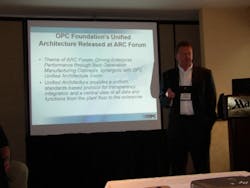OPC Foundation Releases OPC-UA Specifications
The OPC Foundation announced the release of OPC Unified Architecture (OPC-UA) specifications at the ARC Advisory Group Forum held in Boston on June 27, along with a list of suppliers who now support it. OPC-UA—the latest incarnation of the OPC connectivity standard—is a series of specifications intended to expand the framework for moving information among applications in the enterprise space. It works by unifying existing OPC specifications with Web Services as the key technology enabler. Applications expected to benefit from the new data communication specification include asset management and resource modeling.
"The OPC Foundation’s Unified Architecture is technology driven by plant floor trends of decentralization, interoperability between the plant floor and the enterprise, and linking multiple generations of legacy automation products," stated Tom Burke, OPC Foundation president and executive director. "The OPC Foundation's Unified Architecture is platform independent and provides an infrastructure that is scalable and able to be deployed in devices ranging from the plant floor to the enterprise."
Foundation services
OPC-UA provides a base foundation of services for discovery, read/write and subscription capabilities, and for moving information that is described in the specifications of other industry standards organizations focused on information modeling.
"The strategy behind the OPC Unified Architecture is to leverage collaboration with other industry standards organizations," according to Craig Resnick, ARC Advisory Group research director. "OPC Unified Architecture is intended to focus on defining how to move the information models without restrictions from these other industry standards organizations that define the semantics of the content, along with bridging the integration gap between legacy and state-of-the-art automation and enterprise solutions."
The specifications provide a service-oriented architecture (SOA) that facilitates interoperability across corporate firewalls and across platforms in a secure, reliable fashion. By front-ending data as a wrapper on top of the existing legacy OPC installed base, OPC-UA defines the wrapper technology that supports legacy OPC installations.
OPC-UA represents the migration from Component Object Model (COM)/Distributed COM (DCOM) to SOA-based .Net technology. According to Chris Colyer, Microsoft's worldwide director of process manufacturing, "The OPC Foundation's Unified Architecture technology is closely aligned with Microsoft's Windows Communication Foundation, which makes it easy for manufacturers to use Microsoft technology to build OPC Unified Architecture components. The requirements of OPC Foundation's Unified Architecture for scalability, reliability and performance align well with the direction that Microsoft has established for providing the tools and components necessary to develop products efficiently."
Early adopters
The deployment strategy consists of an early adopter development program among suppliers that have demonstrated commitment to building products based on the OPC Foundation Unified Architecture.
Members of the OPC Foundation Early Adopter Program have jointly developed common OPC-UA wrappers for existing Data Access, Alarms & Events, and Historical Data Access (HDA) servers.
The following OPC members are the core team for the OPC Foundation early adopter team: 4CE, ABB, Absynt, Advosol, Allmendinger, Ascolab, Beckhoff, CAS, Cognex, Cyberlogic, Emerson, GE, Honeywell, Iconics, Indusoft, Invensys/Foxboro, Kepware, Matrikon, Microsoft, OSISoft, Prosys, Rockwell, SAP, Siemens, SISCO, SMAR, Softing, SoftwareToolbox, SRI, Technical Research Center Finland, Technosoftware, Wapice, Wonderware and Yokogawa.
For more information, visit the OPC Foundation, www.opcfoundation.org.

